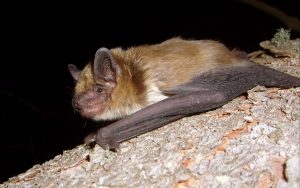
The Big Brown Bat is the most prevalent species at Hopkins Hollow. It is a state threatened species.
Everyone loves little furry animals. Even bats, right? Here is the latest, just in, on our Bat Monitoring Study in Hopkins Hollow. An acoustical monitor was placed in three locations during the 2023 Bat breeding season. The study was funded in part by a generous grant from the Natural Resources Foundation of Wisconsin, Bird Protection Fund. Our monitoring confirmed, that, of eight species of bats occurring in Milwaukee County, four were found at Hopkins Hollow during the 2023 maternity season: Big Brown Bat, Eastern Red Bat, Hoary Bat, and Silver-haired Bat. The Big Brown Bat is state threatened, and Silver-haired Bat is a Special Concern species.

The Eastern Red Bat was confirmed at one site. Eastern Red and Hoary bats were in low numbers compared to other nearby preserves.
We conducted acoustic surveys for bats during the maternity season (June-July) in 2023. This study summarizes these baseline inventory data, provides a checklist of species found, quantifies bat activity levels on the property.
Hopkins Hollow is the name we’ve given to an approximately 20-acre flood basin , mostly owned and operated by the Milwaukee Metropolitan Sewerage District in Milwaukee. A smaller section is at the North end is owned by Milwaukee County Parks. The area is bounded on the North by Hampton Avenu, on the South by W. Congress Avenue, on the west by Hopins, 35th and 34th Streets and on the east by the 30th Street Corridor RR Tracks.
Lincoln Creek flows through the study site from south to north, resting on limestone bedrock. It is a flashy urban stream with mostly grassed banks, a few shrubs and trees lining the banks, and mostly poor water quality typical of urban streams receiving significant road runoff. There are no backwaters or ponded areas in the stream. The surrounding slopes have been excavated, down to bedrock in places, to form a basin to maximize flood water retention.
We conducted acoustic surveys for bats during the maternity season (June-July) in 2023. The study summarizes these baseline inventory data, provides a checklist of species found, quantifies bat activity levels on the property. A copy of the 15 page study report is available at this link. It includes maps, photos, graphs and full details on the study design, execution, and data analysis.

Recent Comments